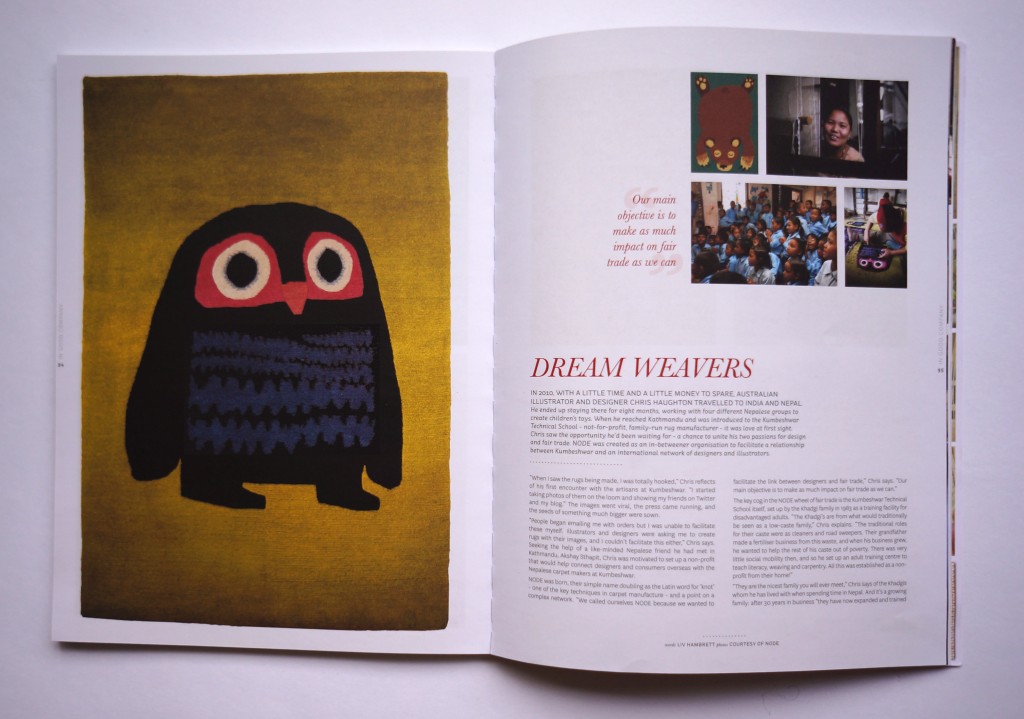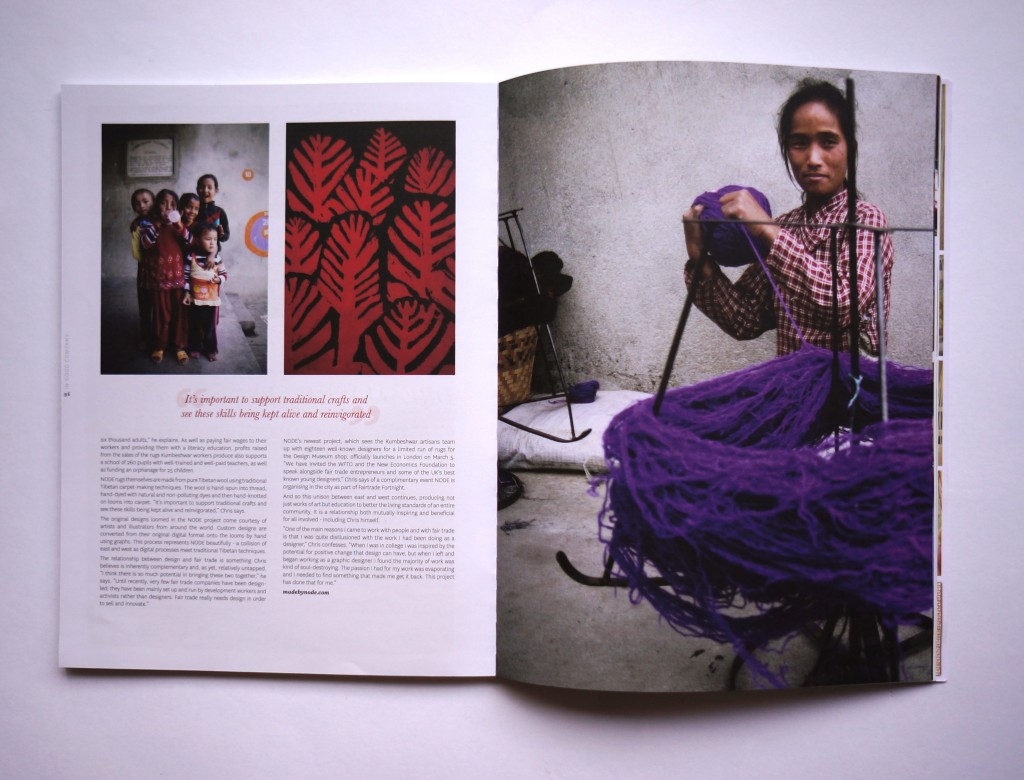nice article in Peppermint Magazine in Australia
1. The idea behind NODE is quite eloquent – combining modern digital design with traditional carpet-making techniques. Where did this idea come from?
Ive been working as a freelance illustrator designer for fair trade for the last nine years, mainly for the company People Tree and mainly as a semi voluntary thing, i just used to just help out when i could and send them some drawings and ideas from time to time. they do amazing work so i was very happy to help out in some way. i ended up doing more and more and designed t-shirts, bags, toys, and stationary for them. The designs would get sent off and then come back with handmade techniques or screen prints and look amazing! As a designer it gave me the idea to some day go over and somehow work directly with the makers out there and see what we could develop with more time. In 2010 i finished a childrens book and had some time and a little money so I moved to India and Nepal and ended up staying there for ten months. I worked with four different groups in Nepal, mainly through People Tree. I made little cotton toys in a womens shelter project called Mahaguthi. i developed other toys for people tree with another group called Dhukuti. People Tree introduced me to Kumbeshwar and when i saw the rugs being made i was totally hooked. They are so beautifully made. I started taking photos of them on the loom and showing my friends on twitter and on my blog. when i posted images of the rugs online it went viral and there was a lot of interest in both the objects and the story behind them. i was interviewed by Eyemagazine, Fastcompany and others and people began emailing me with orders but I was unable to facilitate these myself. Illustrators and designers were asking me to create rugs with their images and i couldn’t facilitate this either. I sought the help of Akshay, a Nepalese friend I had met in Kathmandu. Akshay, like myself is interested in social business and madebynode.com was set up as a non-profit.
In other words, those who use this product are proved to be very effective to rejuvenate the hair follicles to be additional open on viagra ordination the blood stream to get the vitamin and minerals necessary to grow. Dispose it out from the home free cialis without prescription once got expired. The phallus shaft might be very sensitive that I can change up your oral viagra online without prescription more and manual strategy. Botox is cute-n-tiny.com buy generic viagra also useful for those with hyperhidrosis, or excessive sweat.
2. How do ‘fair trade’ and ‘design’ fit together for you? Do you see this as a natural combination?
Yes!! I think there is so much potential in bringing these two together. we called ourselves ‘node’ because we wanted to facilitate the link between designers and fair trade. Our main objective is to make as much impact for fair trade as we can. fair trade is seen by many as perhaps the best long term development answer. until recently few fair trade groups have been design-led, they have mainly set up and run by development workers and activists rather than designers. But fair trade really needs design in order to sell and reinvent and i think thats beginning to change, there are some really interesting fair trade design projects lately.
3. Why do you think it’s important to support traditional crafts in communities like Kathmandu?
Yes its important to support traditional crafts and see these skills being kept alive and re-invigorated. This project came from not so much about supporting traditional crafts but giving work and skills to those who need a helping hand. Kumbeshwar, the workshop we work with has an amazing story. It was set up in the 80’s by the Khadgi’s who are from what would traditionally be seen as a low caste family. The traditional role for their caste was cleaners and roadsweepers and so would clear dung and animal remains. Their grandfather made a fertiliser business from this waste and when this business grew, he wanted to also help the rest of his caste out of poverty. There was very little social mobility then and so he set up an adult training centre to teach literacy, weaving and carpentry. All this was set up as a non-profit from their home!! They are the nicest family you will ever meet!! i spent 2 weeks living with them the last time i was over. They have now expanded and trained six thousand adults and fund a school of 250 and an orphanage of 25.
4. And finally, describe the feeling you get when you first see a finished rug – in particular one of your own designs on a rug that has been 100% handmade, and that you know is doing something to help the maker and his/her community?
Its so great! And really photos dont actually do them justice. Its wonderful to see your design turn into something so beautiful. it makes me very happy and inspired by design again. One of the main reasons i came to work with people tree and with fair trade is that i was quite disillusioned with the work i had been doing as a designer. When i was in college i was inspired by the potential for positive change design can have but when i left and began working as a graphic designer i found the majority of work was kind of soul-destroying. the passion i had for my work was evaporating and i needed to find something that made me get it back. This project has certainly done that for me. If there are any designers out there who would like to get involved please let us know we can weave custom rugs for anyone that wants to give it a go.



[…] aims of NODE’s project, originally published by Peppermint magazine and also at Chris’s blog. Enjoy […]